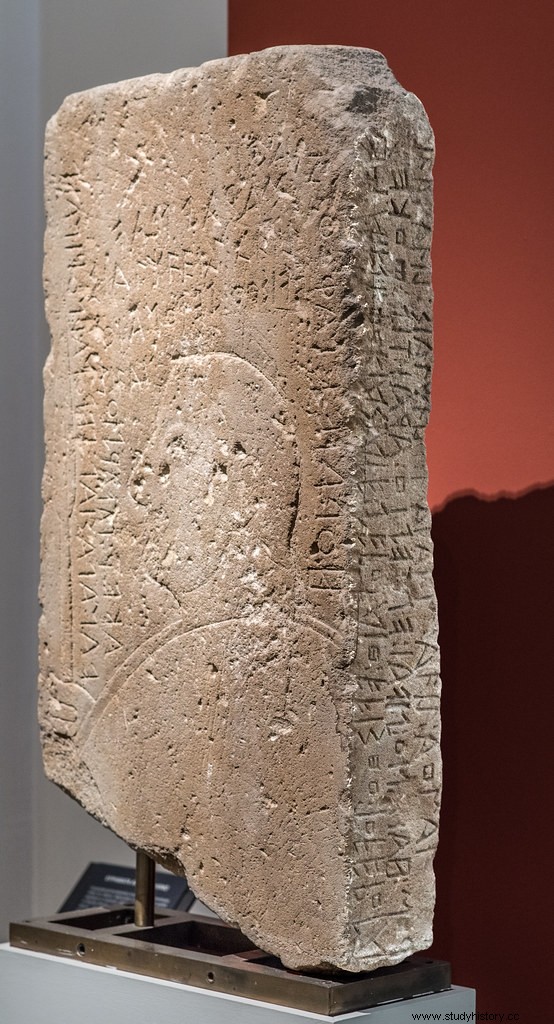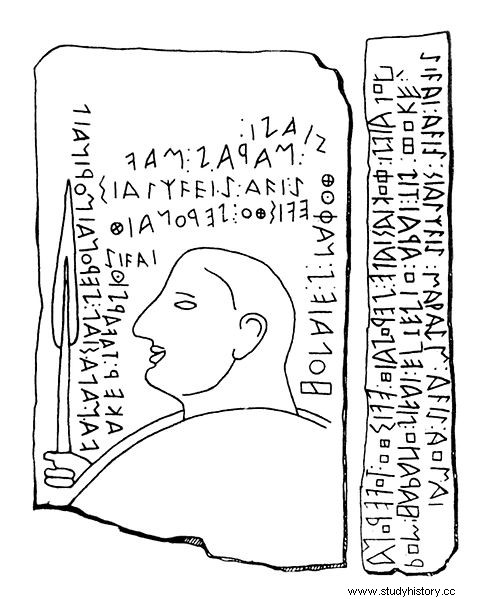In 1885, forming part of the walls of a church in the town of Kaminia on the Greek island of Lemnos, a unique stele with inscriptions not yet deciphered was found.
It has been dated to the 6th century BC, prior to the conquest of the island by the Athenians in 510 BC. to the Pelasgians. This was the name given by the Greeks to the pre-Hellenic peoples who inhabited what we know today as Greece and the Aegean islands.
The Pelasgians, about whom researchers do not agree on whether they had Indo-European origin or not, spoke a group of languages whose origin is also uncertain, although there are theories for all tastes.
The stele and its inscription

The stela shows a low-relief engraving of a warrior in profile and without a helmet, carrying a spear and a shield that, due to the curvature of the incision, appears to be circular. Around the image there is an inscription written in boustrophedon, that is, writing one line from left to right and the next from right to left or vice versa.
There are 198 characters that form between 33 and 40 words, separated in some cases by one, two or three points. It has three parts on its forehead, two written vertically in the image of the warrior and one horizontally above his head; and one side. As we said, the language in which it is written has been called lemnian and, although it can be transliterated, it has not yet been possible to decipher what it says. By comparison with Etruscan, a language with which it seems to have many points in common, the phrase aviš sialχviš is interpreted (sixty), reminiscent of Etruscan avils maχs śealχisc .
The researchers' transliteration is as follows, on the front:
And on the side:

What is known is that the alphabet used in the inscription is a variant of the Euboean alphabet, similar to that used to write the Etruscan language and the oldest Phrygian inscriptions. The Euboean alphabet was used in the cities of Eretria and Chalcis, both on the island of Euboea, and in its southern Italian colonies such as Cumae and Pitecusse (present-day Ischia). It was precisely through this variant that the Greek alphabet spread throughout the Italian peninsula, giving rise to the Etruscan and Latin alphabets.
The Lemnian language
Due to the similarity of the alphabet, at first the researchers thought that the language of the inscription was Etruscan, but it turned out to be different, although both have many similarities. It was called lemnium and the existence of a linguistic family called Tyrsenic was proposed. or tyrrhenian , from which Lemnian, Etruscan and Rhaetian would derive (a language attested to by numerous inscriptions in the ancient Roman province of Recia, that is, between Switzerland, Bavaria and Tyrol).

Numerous pottery shards with similar inscriptions were later found, which would show that the lemnian it was spoken on Lemnos at least from the 16th century BC.
The researchers who defend the belonging of these three languages to the same linguistic tree have found common features in their morphology, phonology and syntax. An analysis of lexical correspondences has not been possible, due to the paucity of Lemnian and Rhaetian inscriptions, and the fact that the three languages had to separate before the Bronze Age. That is, they would be Paleo-European, prior to the arrival of the Indo-European languages in southern Europe.

A theory for the presence of a Tyrrhenian language as remote and isolated from the other two as is the lemnian , is that it could have reached the Aegean at the end of the Bronze Age, when the Mycenaeans recruited mercenaries in Sicily, Sardinia and the Italian peninsula.
In this sense, already in the 1920s, Professor Della Seta stated, following excavations in one of the island's necropolises, that:
The Pelasgians
Greek tradition held that the Pelasgians had inhabited large parts of Greece before the arrival of the Hellenes, particularly Thessaly and Attica. Homer mentions them in the Iliad among the allies of Troy, and in the Odyssey they appear as one of the tribes of the ninety cities of Crete.
And Herodotus says that the Pelasgians of Lemnos had lived in Attica, but had been expelled from there by the Athenians. Regarding his language, he states:

According to Christopher Smith, all this can be interpreted in various ways, as long as there is no concrete documentary and archaeological evidence:we can be before a people, the Pelasgians, from whom the Etruscans and the Rhaetians would be descendants; or on the contrary they could be Etruscan emigrants displaced to the east; but there could also have been an ancient people, whom we call the Tyrrhenians, settled both in the east and in the west, a common stock of Pelasgians, Etruscans and Rhaetians, and this would explain, for example, why Herodotus places them near Thessaly.
Finally, Robert D. Morritt in his work Stones that Speak points out a possible interpretation of the inscription:it would be the funerary stele of a magistrate named Holaie , deceased at 40 or 60 years. However, the complete translation remains, today, impossible.
The stela is part of the collection of the National Archaeological Museum of Athens.
